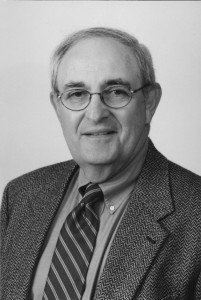This post is part of The Plank Center’s Legacies from Legends in PR Series that was begun in recognition of the 40th Anniversary of the Public Relations Student Society of America in 2007.
Management consultant at Thomas L. Harris & Company, educator and the former president/partner of GolinHarris. Named one of the 100 Most Influential Public Relations People of the 20th Century by PR Week and winner of the PRSA Gold Anvil Award (2000). Adjunct professor in the master’s program in Integrated Marketing Communications, Medill School of Journalism, Northwestern University. Author of four books, including “The Marketer’s Guide to Public Relations in the Twenty-First Century.”
It’s almost impossible for me to realize that I have been privileged to practice public relations for nearly a half-century. Working in the profession has always been a joy. I have seen public relations evolve to become an integral part of every business and organization.
In college, I knew a lot about the history of Western art, and I could analyze the structure of a well-made play and discuss the philosophy of socialism, communism and democracy. But I didn’t have the slightest idea of what public relations was. Only after I was drafted into the Army and assigned to the Army Information School did I learn that this thing we called public information in the military was called public relations in civilian life.
I’d like to share some little wisdoms that I have picked up along the way that may be helpful to you.
- Don’t be greedy. Don’t accept the job that pays the most. Choose the one that will offer you the best opportunity to learn, stretch and grow. Good things come to those who wait.
- Always rely on straight talk. Be obsessively clear and concise. Waste the jargon and the bull.
- Go the extra mile. Quality service is at a premium today in all business. Especially ours.
- Don’t have public relations tunnel vision. The client will rely on you if they think of you as a business advisor and not a vendor.
- Be a great team player. Teamwork works. The joy of the business is working with many talented people and being a member of a winning team.
- Remember the nice touches. Money talks and perks work–but little things still mean a lot to the people who are most important to you. I still keep some handwritten notes that I received from my first boss 40 years ago. E-mail is convenient, but a personal note, a book or a lunch with the boss are forever.
- Keep up or drop out. The practice changes faster than the speed of light. Change is the law of life, and the internet has changed the ball game forever.
- Take the business seriously. But don’t take yourself too seriously. Nobody likes a know-it-all. Public relations isn’t brain surgery or rocket science. Don’t be too disappointed if your pronouncements are neither little noted, nor long remembered.
- Give credit where credit is due. Somebody else may have a better idea. That somebody may be the somebody you work for, or who works for you.
- Keep your sense of humor and have some fun. In the business and in life. Take time to go to a ball game. Visit a museum. Attend a concert. Take in a play. You and your work will be the better for it.
When I concluded 14 years of teaching grad students at Northwestern University, here is what I told my last class: “Truth is what we are all about. Not hype. Not spin. But truth. If public relations is to retain its position as the credible source, we must not blur the line between information and propaganda, between advocacy and salesmanship. The old description of public relations as ‘the conscience of the corporation’ is more relevant than ever in today’s complex society. The highest calling of PR is to keep our organization on straight paths, to counsel the powers-that-be not just to say the right thing but to do the right thing. In the future, our job will be more vital. We will be often called upon to assume the role of gatekeeper that has traditionally been played by the media. Our greatest value to our organizations, the media and our stakeholders must always be to separate information from misinformation and disinformation, and tell it like it is.”
Published: 2007
More from Thomas Harris:
